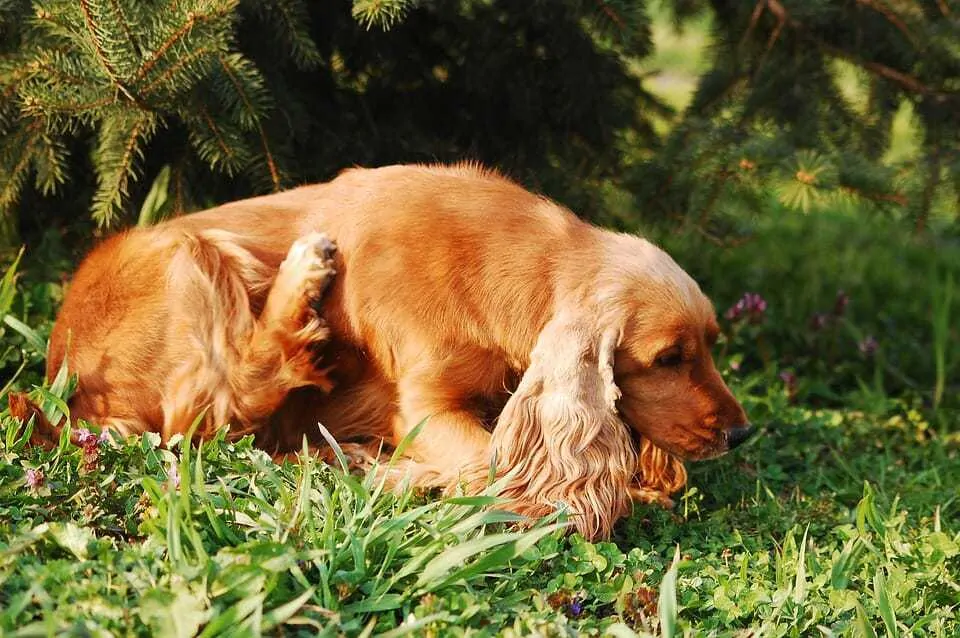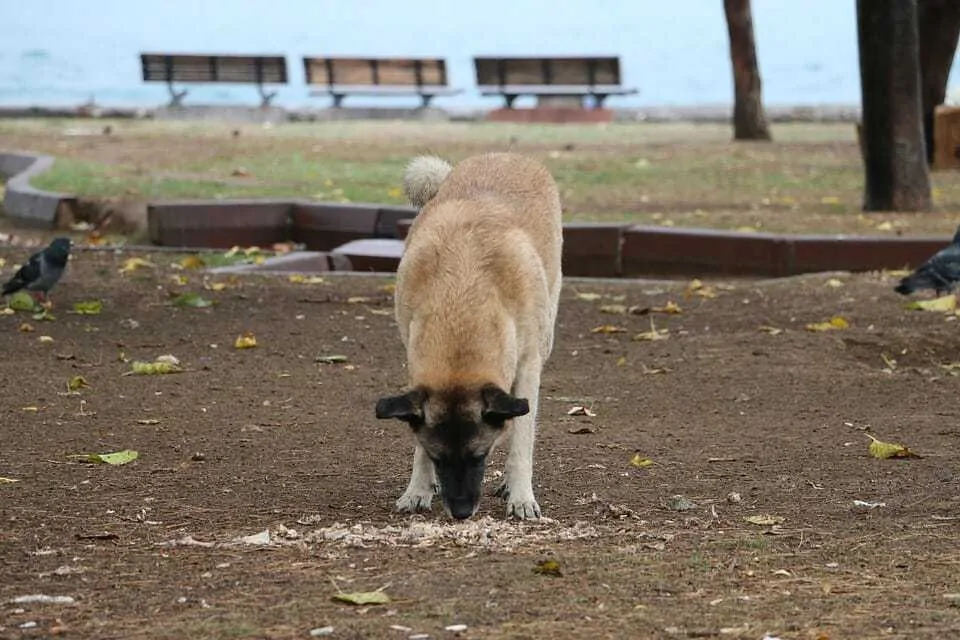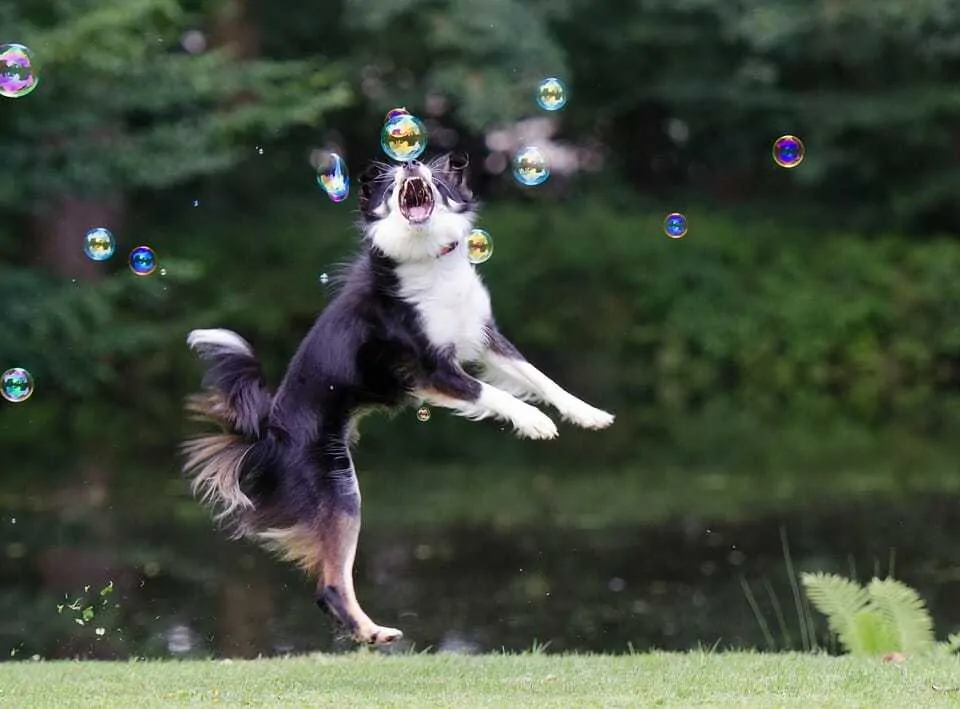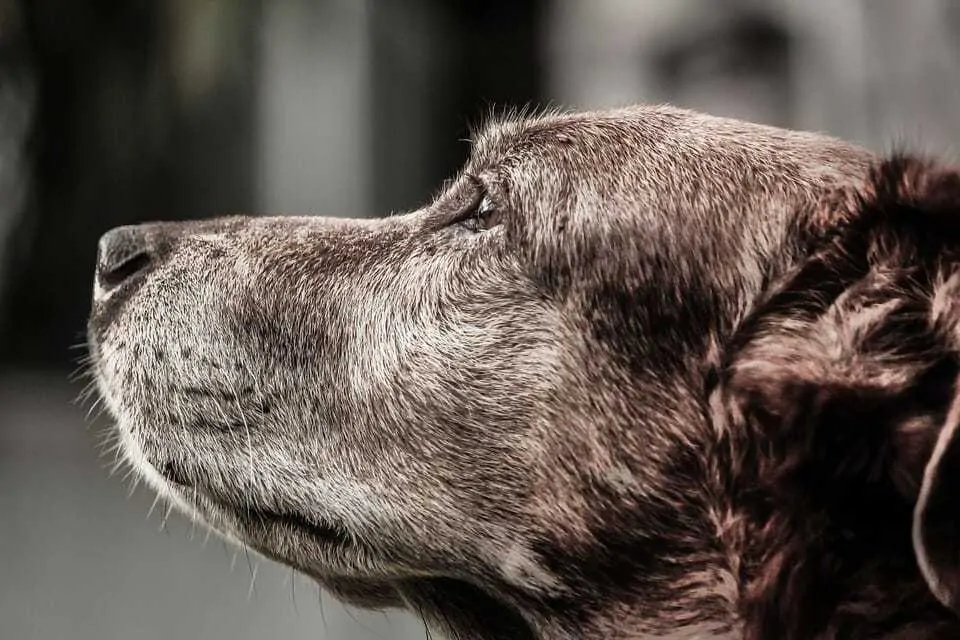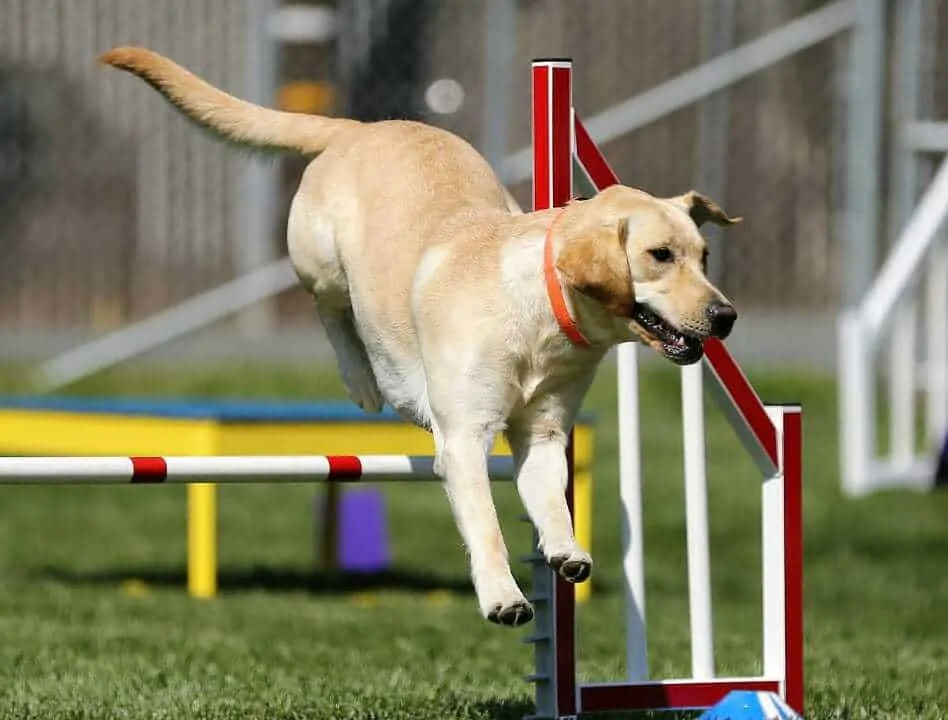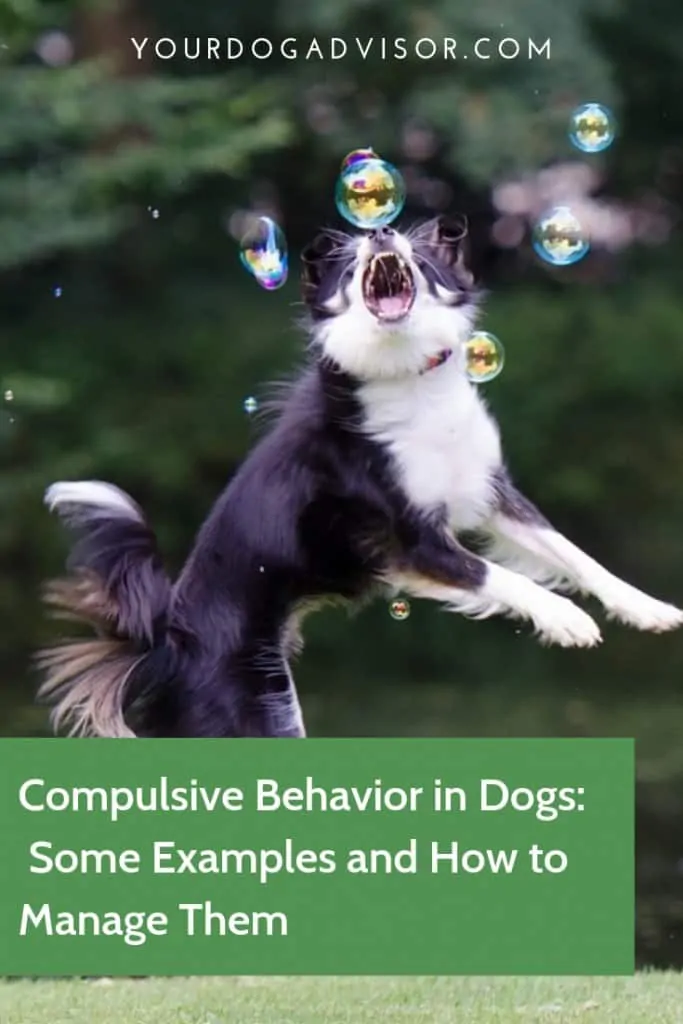Compulsive behaviors in dogs are more common than you might think. Sometimes you may actually be inadvertently encouraging these behaviors to develop in your own dog. Sometimes there may be a medical reason that needs to be addressed, other times it is about management and training, or simply just making sure that your dog has enough enrichment or is able to relax enough for the behavior to stop.
This article will help you understand some of the most common examples of compulsive behaviors, why they may be occurring and how you can help eradicate or manage them.
Compulsive behaviors can surface in a variety of forms and for a variety of reasons; some common ones include obsessive scratching, licking, tail chasing or pacing
Contents
Common Examples of Compulsive behaviors
Compulsive behaviors can sometimes be complex and your dog may display more than one type at a time. Sometimes they can be very obvious and sometimes more subtle. Some of the most common examples are outlined below.
Spinning, Tail Chasing, Pacing
Often a dogs compulsive behavior will manifest itself as repetitive movements like spinning, tail chasing or pacing from side to side or back and forth. Sometimes this will be occasional, when highly aroused or stressed, or only in a particular environment, sometimes it will be more frequent or generalized.
Light or Shadow Obsessions
This is one that is often seen in particular breeds and it can grow in its intensity very rapidly. The dog may become obsessed with specific types of lights or with obvious shadows. Sometimes it will be so unhealthily intense that it can be difficult to snap them out of their focus on the chasing behavior and they can become sensitive to other lights or movements too.
Pica
Pica is where your dog develops an unhealthy obsession with eating things. This will often include things that are not meant for consumption. For dogs that can include stones, sticks and even socks. It can be very dangerous as it can result in sickness and blockages.
Some dogs can become obsessed with drinking water too and this is called Polydipsia.
Pica is the term used for when dogs obsessively eat inappropriate items
Chewing, Scratching, Itching
While these obsessive behaviors can be triggered by something like an allergy, or as the result of a particular ailment or injury, once they get into the habit they can be difficult to break. Often dogs will lick a spot so obsessively that they get what is called a lick granuloma. This sometimes results in a bald patch where the hair once was, but it can also become an open sore and then this can lead to the risk of infection.
Sucking behaviors
Some dogs can become obsessed with sucking. They may suck on a particular object like a blanket or a toy. Some dogs may suck constantly on their own flanks and this can be more of a problem in terms of the damage that they can do to their own body.
Aggressive behaviors
Some dogs may have explosions of unexplained aggression. They may aggressively bite their own body or they may start to attack their own bed or food bowl or some other object around the house.
Compulsive Vocalizations
Some dogs will self soothe with obsessive noise. They may bark constantly or in a particular rhythm or pattern, they may constantly whine or howl (sometimes this may be more common when in a stressful situation).
Dogs can develop an obsession with vocalizing. It can be anything from barking, to whining to howling. Sometimes it can be because it is self-soothing
Why Can Dogs Develop These Compulsive behaviors?
Obsessive behaviors can develop for a variety of reasons, sometimes it can be a combination of things too. Some of the reasons why they can start to manifest are outlined below.
Breed Predisposition
For some dogs, they may be more likely to develop particular obsessive traits because of their genetics. Some breeds are more predisposed to certain things than others. Of course, this does not mean every dog of that breed will suffer from compulsive behaviors, but it is good to be aware and it will also mean that you can take steps to help avoid the likelihood of a problem developing too.
For example, herding breeds like Border Collies are more likely to become obsessed with light, shadow or tail chasing. Some large breed dogs like the Golden Retrievers, Labradors and Dobermans are known for having a propensity towards excessive licking. Some Spaniels are known for their obsession with chasing flies (often referred to as fly-snapping). Dobermans are also known for flank sucking. Retrievers also have a reputation for being prone to Pica.
Herding breeds, like Border Collies, can be more susceptible to becoming fixated on chasing lights or shadows
Underlying Medical Conditions
Sometimes an obsessive behavior will develop as a result of an underlying medical condition. This is one of the reasons why it is important to always seek veterinary advice if you are seeing certain types of compulsive behaviors or they are particularly noticeable. Sometimes it can help diagnose an untreated condition.
Dogs that are drinking obsessively could have a problem with their kidneys, dogs that are constantly licking a certain area may have an allergy or could even have a form of cancer. Displaced licking can often be a sign that your dog is in pain and it is always important to have this checked out.
Sometimes dogs display increased symptoms of stress if they have conditions involving their thyroid.
Some obsessive behaviors may actually be as a result of neurological problems like epilepsy and they could be linked to seizure activity.
If you have an elderly dog there is the possibility that the introduction of obsessive behaviors could be related to the onset of canine dementia. Pacing, spinning and other repetitive behaviors are often symptoms of this condition.
Senior dogs that have canine dementia can exhibit obsessive behavior
Boredom
Sometimes, when a dog is not getting enough stimulation and enrichment from their environment, obsessive behaviors can start to manifest as a way of relieving boredom.
Environmental Stressors
If your dog is a particularly anxious dog or one that is living in an environment that is particularly stressful for them, then obsessive behaviors can start to develop. They act as a self soother for the dog and can help to keep them distracted and help them to cope with their anxieties. If a stray dog is finding a kennel environment stressful you may find that they pace a lot, howl a lot or even give themselves granulomas as a result of licking.
The behavior Has Been Reinforced by Owners
Sometimes a dog may do something that the owner finds amusing or unusual and they will encourage the dog to do it again and this can then turn into an obsession. This is a common one with dogs that end up with a fixation on chasing lights or chasing their tail. It can sometimes be seen with toys too. For example, if an owner takes a ball focussed Collie to play with a ball launcher too much they can become unhealthily fixated on it and will always be looking for the ball and never want to stop playing with it.
What Can You Do To Help Manage These Types of behaviors?
Depending on the severity of the problem, there are a number of things that you can do to help tackle the problem of your dog’s obsessive behavior. Some of the more common solutions (which may sometimes have to be used in tandem with one another) are outlined below.
Quick Intervention with Distraction or Redirection
Sometimes, if you spot your dog becoming fixated. If you pick up on this quickly enough and work on distracting them and rewarding them for alternative behaviors then, with consistency and vigilance, this can be enough to cure the problem before it gets out of control.
Training
Sometimes a more comprehensive programme of training can help to eradicate the problem. So, for example, if your dog has obsessive vocalisation, if you can work out what triggers this you may be able to tackle this with training.
If they only whine when they are in the car, then it would suggest that they are self-soothing because they find the journey stressful.
It would then make sense to work on getting them more comfortable being in the car. Go back to basics and work on rewarding them for just walking towards the car and then away again, then gradually build up to getting in the car, being in the car with the engine on, going for a very short trip, and then going for a longer journey. All the while they should be rewarded with super tasty treats at each stage whenever they are in a relaxed state. If they become agitated, it likely means you have gone too fast and should go back a step again.
If your dog is obsessively tail chasing, you should ask for an alternative behavior and then reward them when they offer this instead.
Often training will need to be done in combination with other things to help completely solve the problem. There is no point in doing lots of training to sort out tail chasing if they are doing it because they are bored and you are not doing anything to address their overall levels of boredom.
Increased Enrichment
It is important to ask yourself if your dog is getting enough stimulation and enrichment if they are exhibiting any obsessive behaviors. Sometimes giving them more physical exercise like extra walks, the opportunity to take part in dog sports, or even just to have more enriching sniffing time when on a walk can be helpful.
They may also need more enrichment around the home. Are you giving them enough attention and company, would they benefit from a dog walker, do they have enough interactive treat toys around the home?
Making sure that your dog is appropriately stimulated both mentally and physically is important, dog sports like agility can be a great option
Reducing Stressors
For anxious and fearful dogs, it is important to carefully analyse what you think may be causing them to feel stressed and then work on trying to reduce these stressors along with adding in some training to try to help them feel more relaxed around them.
If you notice that your dog exhibits more of these types of behaviors when there are strangers in the home then perhaps you should try to limit the number of strangers visiting the house while you work on helping them to feel more relaxed around new people. If they become stressed when they see people walking past the window then you could consider a freeze on the window pane to minimise their exposure, again, while you work on training.
Medical Treatment
Sometimes, if the behavior is as a result of a medical condition or it is extremely severe and ingrained, your dog may need medical intervention to help treat the condition or to help reduce the obsessive behavior. If it is for the latter, then we would always recommend seeking the advice of a certified veterinary behaviorist to give you support for a long term plan in terms of a behavioral modification programme too. Medication to help alleviate the problem should only be used in extreme cases where the problem is harmful to your dog and is not able to be tackled with training alone.
Don’t Actively Contribute to The Problem
It is important to remember not to exacerbate the problem. It may seem cute when your puppy chases his tail for the first few times, but if you reward them for doing this with praise and attention, it can then mean that they will do this with more frequency until it develops into an unhealthy obsession.
The same is true if you choose to play with your dog using a laser light beam. This can cause your dog to develop an unhealthy fixation and selecting a different game to play with your dog is a better option.
If your dog is overly aroused when playing with a ball, for example, then it would be better to pick a different toy to engage with them to avoid it becoming an unhealthy fixation
Get Qualified Professional Help
If the problem is severe, as mentioned above, don’t be afraid to seek professional help and guidance. Having someone point you in the right direction can save a lot of additional time and stress for you and your dog. Always make sure that you pick a qualified trainer or behaviorist that uses science-backed, reward based methods.
Other Management Tools
If your dog is exhibiting obsessive behaviors as a result of increased anxiety, while you are working on reducing this you may also want to consider introducing some management tools to help alleviate the anxiety. They are not usually a cure-all but, if used alongside a behavior modification programme, they can sometimes take the edge of your dog’s anxiety levels. Products like Calming Plug-Ins, Calming Treats and Comforting Thundershirts can be useful.
No products found.
What Not To Do
While there are lots of things that you can do to try to help manage the problem, there are also some things that you should be careful to avoid doing.
Don’t punish your dog when they do these obsessive activities. Often they will not associate the punishment with the behavior. If they are doing it because they are stressed, then punishing them will only serve to heighten their anxiety further and could make the problem worse or they could redirect it elsewhere.
As mentioned before, don’t encourage them to continue because you think it is funny or cute. It can quickly become out of control before you know it.
Make sure you don’t ignore it and think it will just go away with time. Often these obsessive behaviors escalate quickly and, if it relates to an underlying medical condition then the quicker you seek help the more chance there is of treating it successfully.

Jen Jones is a professional dog trainer and behavior specialist with more than 25 years of experience. As the founder of ‘Your Dog Advisor’ and the ‘Canine Connection’ rehabilitation center, she applies a holistic, empathetic approach, aiming to address root causes rather than merely treating symptoms.
Well known for her intuitive and compassionate approach, Jen adopts scientifically-proven, reward-based methods, encouraging positive reinforcement over punishment. Jen specializes in obedience training, behavior modification, and puppy socialization. Her innovative methods, particularly in addressing anxiety and aggression issues, have been widely recognized. Jen has worked with many of the world’s leading dog behaviorists and in her free time volunteers with local animal shelters and rescue groups.
